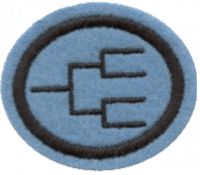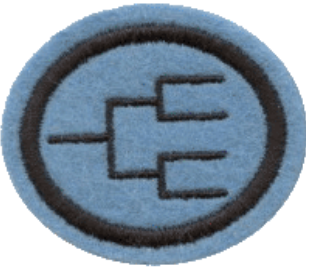Especialidades JA/Genealogía/Respuestas
1
1a
1b
1c
1d
1e
2
2a
Lucas 3:23-38 y Mateo 1:1-17
2b
From Luke 3:
- Adam, Seth, Enosh, Cainan, Mahalalel, Jared, Enoch, Methusala, Lamech, Noah,
- Shem, Arphaxad, Cainan, Shelah, Eber, Peleg, Reu, Serug, Nahor, Terah,
- Abraham, Isaac, Jacob, Judah, Perez, Hezron, Ram, Amminadab, Nahshon, Salmon, Boaz, Obed, Jesse,
- David, Nathan, Mattatha, Menna, Melea, Eliakim, Jonan, Joseph, Judah, Simeon, Levi, Matthat, Jorim,
- Eliezer, Joshua, Er, Elmadam, Cosam, Addi, Melki, Neri, Shealtiel, Zerubbabel, Rhesa, Joanan, Joda, Josech,
- Semein, Mattathias, Maath, Naggai, Esli, Nahum, Amos, Mattathias, Joseph, Jannai, Melki, Levi, Matthat, Heli, Joseph, Jesus
3
- Talk to family members
- Internet
- Library
- Public Records
- Marriage Databases
- Ellis Island Records
- Mormon Records (they believe in baptising for the dead, and have assembled significant genealogy information to facilitate this)
- Census data
- Cemeteries
- Passenger Lists (boatloads of immigrants etc)
- Military Records
- Obituaries
- Newspapers
- Family records (family Bible etc) and
- Personal letters
4
- The National Genealogical Society, Arlington, Virginia
- The Federation of Genealogical Societies
- Federation of East European Family History Societies
- Historical & Genealogical Societies of the U.S.
5
- Interview Family
- Check for family records at your house or those of relatives
- Previous research done by other family members
- Access the internet and begin searching (here are a few of the available options)
6
7
8
Here is a blank four-generation family chart. Fill in the names after "name:", put the date of birth after the "b:", and the date of death after the "d:". If the person has not died, leave the date of death field blank. If you do not know a precise date, put a year (or a range of years). If you do not know a piece of information at all, leave the field blank.
| Great-grandfather name: b: d: | |||
| Grandfather name: b: d: |
|||
| Great-grandmother name: b: d: | |||
| Father name: b: d: |
|||
| Great-grandfather name: b: d: | |||
| Grandmother name: b: d: |
|||
| Great-grandmother name: b: d: | |||
| Yourself name: b: |
|||
| Great-grandfather name: b: d: | |||
| Grandfather name: b: d: |
|||
| Mother name: b: d: |
Great-grandmother name: b: d: | ||
| Great-grandfather name: b: d: | |||
| Grandmother name: b: d: |
|||
| Great-grandmother name: b: d: |
9
- Family tree chart
- Computer Genealogy program
- Family group sheets
10
- a. Primera memoria (recuerdo más antiguo)
- b. ¿Cuándo y dónde nació usted?
- c. Primera iglesia que recuerda haber asistido
- d. Nombres de las escuelas y la ubicación, a las que asistió
- e. ¿Donde vivió entre las edades de diez y catorce años?
- f. ¿De qué país emigraron nuestros antepasados?
- g. ¿Dónde y cuándo se casó?
- h. Si tuvo hijos, por favor decir sus nombres, lugar y fecha de nacimiento
- i. Escribir un agradecimiento a su familiar por su tiempo e incluya una foto deusted mismo y preguntar si estaría dispuesto a compartir una copia de una foto antigua de la familia con usted.
It would be a good idea to let your relative know ahead of time that your are interested in family history. He (or she) may surprise you with a wealth of documentation, and is sure to be delighted to share this information with you. You might get to read love letters your great-grandfather wrote to you great-grandmother, or see photographs you have never seen before. You may hear stories of long-dead relatives, or learn things you never knew about living relatives (such as your parents). It would be a good idea to bring an audio recorder so you can go back and listen to the conversation again. Such a recording will become a valuable part of your family's history.
11
11a
See requirement 8 for a chart, or use a computer program to record the information (you'll need to print it out in order to share it as per part e).
11b
These records would include any of the following:
- Birth certificate
- Child dedication certificate
- Baptismal certificate
- Marriage license
- Military orders (assignments)
- Deed to family property
There is no reason for you to use the originals when you share this information with others, as the consequences of loss or damage can be severe. It would be better to make a photocopy. These days, identity theft has become a significant concern, so you may wish to black out some information but only on the copies. The Social Security number of living person should never be shared with anyone who does not have an official need for it.
11c
These can be put in a photo album, mounted on a display board, or made into a computer slide show.
11d
If the stories have not already been recorded in writing, write them down. Even if you have an audio recording, a written record is still important, because audio technology changes over the years. It is entirely possible that you will be unable to find a tape player to play a cassette recording of your great-aunt's story in the future. CD's are nearly certain to fall victim to technology's relentless advance as well. This also applies to word processor files - print them out! It's already very difficult to read computer files that were created ten years ago, and nearly impossible to read ones created 20 years ago. A written copy printed on acid-free paper will last for centuries if properly stored, and no special equipment is needed to read it.
11e
If you are working on this honor as a group, you can all get together and share your information. You can also host a get-together and share your personal history then.
12
- a. Clases de información disponible
- b. Cualquier información nueva que descubrió acerca de su familia
Not all public libraries have genealogy sections, and some have tremendous collections. Call or visit your local public library and ask the librarians. They should be able to either tell you where their genealogy section is, or tell you the nearest library with a genealogy section.
Once you find the genealogy section of a local library, you should plan to spend a couple of hours there doing some research. Bring a notepad and a pen (or a notebook computer) with you and dig in.
If you are planning to bring a group of Pathfinders to the library, be sure to call ahead of time and let them know of your plans. They may be willing to present an orientation session.
The types of information that will be available will vary from one library to another, but you might expect to find any of the following:
- Family histories
- Census records (Federal and State, including other states)
- City Directories
- Passenger Lists
- Military Records
- Land Ownership Maps
- Native American Records
- African-American Records (including slave records)
- Online Databases
- Local Histories
- DAR Records
- Church Records
- Early Newspapers
- Vital Statistics Records (birth, marriage, and death)
- Tax Rolls
- Voter Registration Data
- Conviction and Incarceration Data
In many cases, the library will prohibit the making of photocopies of these records because of their fragile nature. However, many have programs in place to microfilm or digitize their collections. Before making any copies, check with the library staff. If possible, you should print copies from the digital or microfilm resources. Many libraries will charge a small fee to cover the costs of duplicating, so be prepared for that.
13
- a. Los nombres de tres familias diferentes
- b. Las fechas de nacimiento y la muerte de estos miembros de la familia
- c. La duración media de vida de estos miembros de la familia
Consider completing this exercise when doing tge next requirement.
Finding the names of three different families will be relatively easy, assuming that people from at least three families are buried there. Simply walk the grounds reading the headstones, and pretty soon you will notice a surname that gets repeated. Write that down, and then start taking note of birth and death dates. Then keep looking. More names will become apparent.
In order for an average lifespan to have any meaning, you will need data on at least eight or so individuals. Be careful not to discard data because it does not suit your preconceived ideas. This means you will record infant deaths as well as the deaths of the aged.
Determine the age at death of each individual by subtracting the date of birth from the date of death. This is most easily accomplished by use of a spreadsheet program. To do this, create four columns, and label them Name, Birth, Death, and Age. Date for the first three columns should be entered in directly. Enter dates in the form:
- "11/26/1827"
Be sure to enter a four-digit year, especially if it occurred more than 50 years ago. For the age column, assuming you are on row 2, enter the formula
- =(C2-B2)/365.24
This will make the spreadsheet calculate the person's age at death. Once you've entered that into one cell, you should be able to copy it into the others (select the cell, type ctrl-C - then highlight a column of cells and type ctrl-V. This will paste it into each highlighted cell and automatically adjust the cell references for you). The result should look something like this:
| A | B | C | D | |
| 1 | Name | Birth | Death | Age |
| 2 | E.G. White | 11/27/1827 | 7/16/1915 | 87.63 |
| 3 | James White | 8/4/1821 | 8/6/1881 | 60 |
Once you have the data entered for several families, you can average the ages per family using the spreadsheet's =AVG() function.
14
This is one area where phone books are still better than an Internet search. Few cemeteries maintain an online presence, but most are listed in the white pages of a local telephone directory. If you have not chosen a cemetery for this requirement, look in the yellow pages and choose one. If you already have one in mind, check the white pages. Then make a phone call to find out how they do maintenance. You may be better off choosing a small cemetery, as they do not generally retain a large force of groundskeepers. You may wish to call several cemeteries before committing to helping one in particular.
Large active cemeteries may not welcome your help but a smaller inactive cemetery may never get attention. Try checking with the city/county office or the agency that licenses cemeteries in your State/Province or region. You might also check with church run sites. Some cemeteries hold an annual picnic at which they collect funds from the people who have families buried there. In years past these picnics were called "graveyard cleanings" because the people would actually assemble to mow, weed, and clean the grounds. At lunchtime they would take a break and eat a potluck picnic. Later, this practice changed so that the people would contribute money for the cemetery's upkeep, but the picnic aspect was retained.


